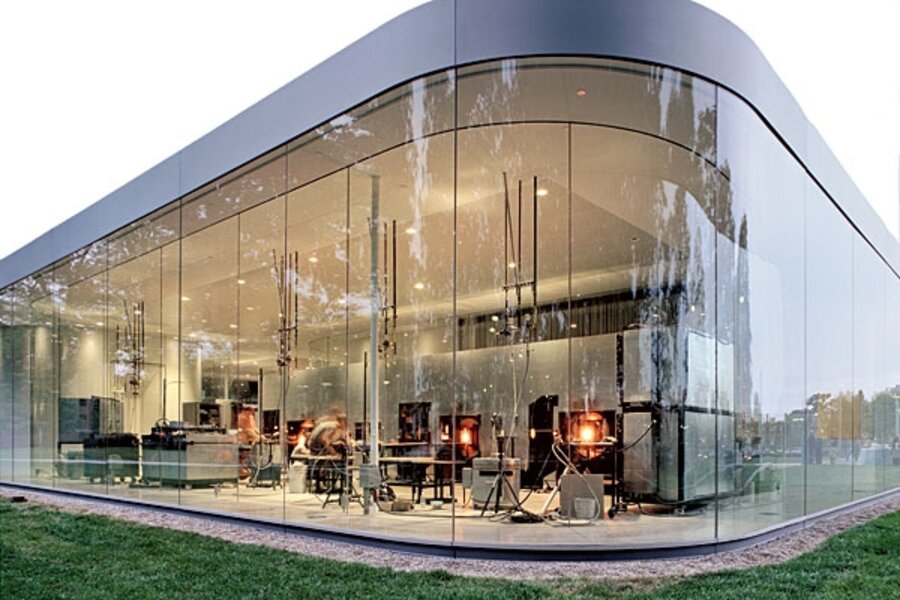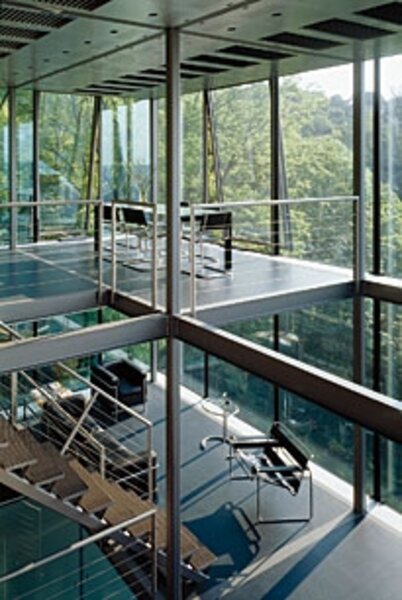The new science of glass
Loading...
Eighty-one years ago, architect Frank Lloyd Wright marveled at an old material that he helped give new meaning.
"What is this magic material, there but not seen if you are looking through it?" he asked in an essay. Mr. Wright responded to that question – one that has fascinated architects and engineers before and after his work – by calling glass a "supermaterial" and frequently incorporating it into his designs. With prescience, Wright believed that future buildings would be constructed where "Walls themselves because of glass will become windows and windows as we know them as holes in walls will be seen no more." Would Wright be surprised to see how his vision of glass architecture has come true in 2009?
The prevalence of towering glassy skyscrapers would probably not shock him – but the changing nature of glass itself might.
"Glass has become less about abetting observation; it is something to be observed in itself," explains Michael Bell, a professor of architecture at Columbia University, in his recent book and DVD "Engineered Transparency – The Technical, Visual, and Spatial Effects of Glass."
In a phone interview, Mr. Bell says that glass is no longer a single material, "but the name of the family of building materials 'rewritten' by new technologies."
Thanks to breakthroughs and continued stoking by architects, engineers have created glasses capable of things Wright would have never dared to attempt. In doing so, Bell says, "glass may have become something other than glass."
The traditional glass recipe – mix sand, soda powder, and quicklime, then heat until transparent – delivers unpredictable strength and fragility.
But in the 20th century, Wright and other architectural pioneers began designing buildings where interior daylight and landscape views were highly valued. To accommodate their imagination, architects urged engineers to craft new glass formulations with increased capacities to predictably perform structurally and artfully.
The age of skyscrapers became possible through the invention of strengthened glass able to bear ground and weather changes, and unforeseeable human activities.
To understand the demands placed upon glass in high-rise buildings, think of a car windshield: It consists of a sandwich of two layers of glass with a layer of a clear synthetic resin between. The resin layer seals the glass sheets together and, in the event of a crash, prevents them from breaking into tiny shards. These "interlayers" have since contributed to novel "hybrid glass," possessing previously unimaginable strength under enormous loads.
In the 21st century, innovative glass technology has been driven by concerns with climate change, energy conservation, and urban sustainability.
For example, the heating and cooling needs of American buildings amount to an enormous collective energy bill – and estimates say one-third of a building's energy expenditure comes from heat seeping through traditional windows. Conversely, window glass can intensify the sun's rays during summer, forcing millions to reach for the air conditioner.
However, by using argon or krypton gas between glass panes, solar heat can be better managed.
Another technological wonder is "smart glass," or to use the proper term, "electrochromatic glass."
It is coated architectural glass that changes its properties from moment to moment depending on changing light conditions. Under direct light, the panes darken, controlling how much glare and heat pour through the windows without relying on curtains or blinds that can obstruct views.
"Self-cleaning glass" comes coated with a thin layer of titanium oxide that is activated by the sun's ultraviolet rays. The resulting reaction causes dirt on the window to dissolve. The titanium coating also stops raindrops from beading, thus reducing spotting.
These innovations in glass technology come with a price – literal as well as artistic.
"Each manipulation for improved energy performance makes glass less like glass and more like other nontransparent materials, such as metals, ceramics, and stone," said architect and consultant Robert Heintges at the 2007 Columbia University conference on glass in architecture that inspired Bell's book and DVD.
Mr. Heintges's consulting firm in New York has worked on more than 30 million square feet of building facades internationally. He must often balance aesthetic transparency with energy performance. When glass is tinted, sandwiched with different materials, or coated, it can boost the building's green credentials, but it also can diminish the windows' transparency, thus diminishing the purpose of using glass in the first place.
People might talk about wanting a "green building," he says. Yet how many will sacrifice dazzling views through wide expanses of glass for the sake of energy conservation?
Such trade-offs have begun to fade, as green-minded architects and high-tech engineers collaborate more closely and more creatively.
Boston's Institute of Contemporary Art, completed in 2006 on the city's harbor front, features a long glass protrusion that houses its theater. The dramatically cantilevered building offers panoramic views of Boston Harbor thanks to designs by Diller Scofidio + Renfro and technical work by Arup Engineering. The center's 325-seat theater boasts a massive glass wall capable of instantly changing from transparent to opaque in synch with any performance on stage.
Sometimes the engineer and architect are the same person. Werner Sobek showcased his dual skills with "House R 128," a four-level, glass-wrapped, solar-powered house he designed for himself just outside Stuttgart, Germany. Constructed from 20 tons of glass and 12 tons of steel, the building has no definitely defined rooms and interior walls, with the exception of the bathrooms. Every element of the house can be recycled. Its triple-glazed walls insulate the house so well in winter that no interior heating system is needed, he says.
In North America, one of the most distinct heralds of new glass design is the Glass Pavilion of the Toledo Museum of Glass in Ohio. Designed by SANAA, the firm led by Kazuyo Sejima and Ryue Nishizawa, the Glass Pavilion is a capacious structure holding the Toledo Museum's collection of glass art in an ever-changing, light-filled maze of translucence and transparency.
The museum's lightness (on many levels) is made possible through large panels of curved glass that seem weightlessly suspended – an illusion created through engineering – between the museum's concrete floor and steel roof. Interior glass walls define galleries, and the spaces between these glass walls allow ventilation.
The continuously curving building required advanced technological expertise. Its precisely bent, enormous glass panels shape a structure with no right angles, causing sound as well as light to travel in surprising directions, while confusing conventional perceptions of distance.
Jeff Mack, manager of the Pavilion's Glass Studio, describes the building as "an homage to what is around us" – a park with 150-year-old trees.
Robin Schultes, who teaches glasswork in the pavilion, says, "I'm a weather fanatic. I love being able to see impending storm systems coming in while feeling safe and cozy within the building."
She also enjoys the looks of first-time visitors coming to the Glass Pavilion. "They initially are looking completely at the pavilion – then they turn their attention to the glass collection in it."
In a museum housing more than 5,000 pieces of glass art, this 76,000-square-foot glass museum, made sparkling with 32,000 square feet of glass, reveals how Wright's vision of glass walls has arrived.






